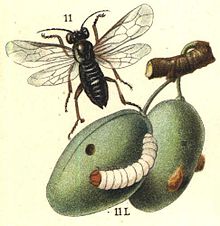Whiteboard
A whiteboard is a tool that is used to record the occurrence of harmful insects . White boards are mainly used on white-flowering fruit trees such as apple , pear and plum trees .
Structure and functionality
White boards are boards made of white cardboard or plastic coated with glue ("insect glue"). The boards should be attached to the trees in the so-called balloon stage, i.e. a few days before the flowers open. Insects such as the apple saw wasp (Hoplocampa testudinea) , the pear saw wasp (Hoplocampa brevis) or the plum saw wasp (Hoplocampa flava, Hoplocampa minuta) held for large flowers and were flown to; the animals then stick to the boards through the glue. After the flowering period has ended, the whiteboards are removed from the trees to prevent other useful insects from being attracted and trapped.
According to the number of captured pests to the White boards using suitable will further control measures, such as pesticides decided.
Alternative color options
The Federal Environment Agency recommends the use of green colored boards instead of the white variant in order to prevent the unintentional capture of useful insects.
The so-called yellow boards work according to a similar principle to the white boards . Their coloration simulates yellow fruits or flowers. Yellow panels are used, for example, to analyze and control the cherry fruit fly .
In addition to the white and yellow boards, variants in blue and red are also used to monitor other insect pests.
Web links
- The color panels - Foundation Competence Center Fruit Growing Lake Constance
Individual evidence
- ↑ Apple saw wasp. Austrian Agency for Health and Food Safety, April 18, 2017, accessed on May 4, 2017 .
- ↑ Current plant protection information in fruit growing. (PDF; 108 kB) Rural Service Centers Rhineland-Palatinate, April 16, 2007, accessed on May 4, 2017 .
- ↑ a b Delicious and healthy pome fruit from our own cultivation. Federal Environment Agency / Federal Ministry for the Environment, Nature Conservation, Building and Nuclear Safety, April 11, 2016, accessed on May 4, 2017 .
- ↑ Apple saw wasp (Hoplocampa testudinea). Federal Agency for Agriculture and Food, August 6, 2010, accessed on May 4, 2017 .
- ↑ Gudrun Görlitz (Ed.): BEAR2FIT - Innovative further developments for leisure facilities for education and recreation . Berliner Wissenschafts-Verlag, Berlin 2011, ISBN 978-3-8305-1979-9 , pp. 96 ff . ( limited preview in Google Book search).
